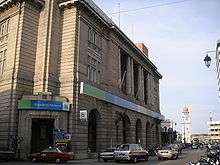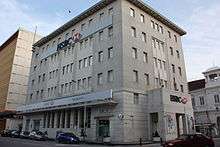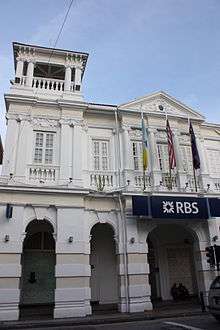Beach Street, George Town





Beach Street (Malay: Lebuh Pantai) is a major thoroughfare and part of the central business district in George Town, Penang, Malaysia. It is also one of the oldest streets in Penang, having been created soon after the founding of Penang by Captain Francis Light in 1786.[1]
The concentration of Malaysian and international banks around Beach Street has made George Town the financial hub within northern Malaysia. In addition, Beach Street is within the UNESCO World Heritage Site, thanks to the colonial architecture of the bank headquarters and other commercial buildings along the street. Administrative buildings built by the British also once stood along Beach Street; however, these buildings were destroyed during World War II.[2]
History
It was created in 1786-87 with the arrival of Francis Light, and is therefore, along with Light Street, one of the oldest surviving roads in Malaysia. As begets its name, Beach Street was originally a coastal road built along George Town's eastern beachhead, and was an important commercial and financial centre during British rule. It also hosted several government complexes, which complemented the nearby magistrates' courts on Light Street (now the State Assembly Building).
Reclamation works from 1883-89 resulted in an extension of the coastline and the creation of Weld Quay, as well as several ghauts (side streets), leading to a minor decline in business along Beach Street as it shifted further inland. Nevertheless, the street continued to flourish as George Town's central business district, and many of these banks still operate to the present day.
List of buildings on Upper Beach Street
Upper Beach Street houses many striking buildings from the British era, with a wide variety of architectural styles. The following is a partial list:
- Standard Chartered Building (Palladian-Art Deco hybrid, 1930). Although the building itself dates from 1930, Standard Chartered has been operating in Malaysia since 1875.
- 1886 Building (Victorian, 1886): arguably one of the most beautiful buildings on Beach Street, with ornate carvings and French windows that open out onto iron-grille latticed balconies. Formerly an upscale emporium.
- ABN AMRO Building (Edwardian, 1905): originally built to house the Netherlands Trading Society, it subsequently served as the local branch of the AMRO Bank and, later, ABN AMRO. It currently houses the local branch of The Royal Bank of Scotland.
- India House (Art Deco, 1937)
- Islamic Council Building (Edwardian, 1907): this is the only remaining wing of a much larger, U-shaped British administrative complex. Once housed the colonial Quantity Surveyor's Department. Much of the complex was destroyed by Allied bombardment in World War II.
- Logan Building (Victorian-Art Deco hybrid, ca 1880s): named after lawyer and activist for local rights James Richardson Logan, the elegant Logan Building is situated at the corner of Beach Street and Bishop Street. It is especially notable for its porte-cochère, which used to lead into an inner courtyard for horse-drawn carriages. It was in poor condition for several decades up to 2008, when it was extensively restored.
- Old OCBC Building (Art Deco, 1938): this distinctive building bears the OCBC junk logo on its façade, unchanged since the 1930s.
- George Town Dispensary (Straits Colonial, 1923): originally commissioned to house the city's primary dispensary, now defunct. The building now serves as the pre-opening office of The Rice Miller Hotel and Godowns.
See also
References
- ↑ "Beach Street (Lebuh Pantai), George Town, Penang / Pulau Pinang". Retrieved 2016-11-27.
- ↑ Langdon, Marcus. A Guide to George Town's Historic Commercial and Civic Precincts. Penang: George Town World Heritage Incorporated.
